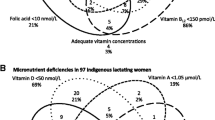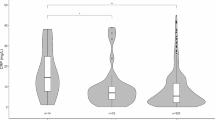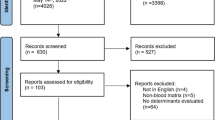Abstract
Numerous factors contribute to perinatal risk, many of which remain undefined. This study sought to determine the frequency of fish intake in postpartum women, and to establish a relationship between the rates of immunoreactivity for antigens from Anisakis spp. and high-risk pregnancy. In this prospective noninterventional study, a structured questionnaire was administered and serum was collected from postpartum women at two perinatal centers (a high-risk birth unit [HRBU] and a low-risk birth unit [LRBU]) in the Niterói municipality of Brazil. Anisakis species-specific IgG and IgE were measured by ELISA. The chi-squared test was performed, and odds ratios (ORs) with their 95% confidence intervals were estimated. The t-test or Mann-Whitney test was applied to continuous, normally distributed variables. In total, 309 women (170 from HRBU, 139 from LRBU) between 24.8 and 26.7 years old with a median of 6 to 8 prenatal visits were enrolled. Women in the two units exhibited differences in some variables, including prenatal care (p = 0.01), maternal and fetal risk (p = 0.00; OR = 6.17), and gestational age (p = 0.00), but no differences in fish consumption (p = 0.29), frequency of fish intake (p = 0.40), allergic symptoms (p = 0.51), or frequency of anti-Anisakis reactivity (p = 0.22). Logistic regression analysis revealed that only age was independently associated with postpartum anti-Anisakis reactivity. This study confirmed a low prevalence of fish intake and suggested that Anisakis spp. had no impact on high-risk pregnancies among this postpartum study population.
Similar content being viewed by others
References
Abouzahr C. 2014. Progress and challenges in women’s health: an analysis of levels and patterns of mortality and morbidity. Contraception, DOI: 10.1016/j.contraception.2014.03.007
Andriamandimbison Z., Randriambololona D.M., Rasoanandrianina B.S., Hery R.A. 2013. Causes of in utero fetal deaths: 225 cases at Befelatanana Hospital, Madagascar. Medecine et Sante Tropicales, 23, 78–82. DOI: 10.1684/mst.2013.0143
Audicana M.T., Kennedy M.W. 2008. Anisakis simplex: from obscure infectious worm to inducer of immune hypersensitivity. Clinical Microbiological Reviews, 21, 360–379. DOI: 10.1128/CMR.00012-07
Boyon C., Collinet P., Boulanger L., Rubod C., Lucot J.P., Vinatier D. 2011. Fetal microchimerism: benevolence or malevolence for the mother? European Journal of Obstetrics & Gynecology and Reproductive Biology, 158, 148–152. DOI: 10. 1016/j.ejogrb.2011.05.008
Brasil. 2012 - Ministério da Saúde, Organização Panamerican da Saúde. “Manual on neonatal IMCI: procedures.” 3 ed. Retrieved 05/04, 2014, from http://www.bvsms.saude.gov.br/bvs/publicacoes/manual_aidpi_neonatal_3ed_2012.pdf
Buschmann C., Schmidbauer M., Tsokos M. 2013. Maternal and pregnancy-related death: causes and frequencies in an autopsy study population. Forensic Science, Medicine and Pathology, 9, 296–307. DOI: 10.1007/s12024-012-9401-7
Caballero M.L., Moneo I., Gomez-Aguado F., Corcuera M.T., Casado I., Rodriguez-Perez R. 2008. Isolation of Ani s 5, an excretory-secretory and highly heat-resistant allergen useful for the diagnosis of Anisakis larvae sensitization. Parasitology Research, 103, 1231–1233. DOI: 10.1007/s00436-008-1105-2
Corres L.F., Del Pozo M.D., Aizpuru F. 2001. Prevalence of Anisakis simplex sensitisation in three Spanish areas, in relation to the fish intake rates. Relevance of Anisakis simplex allergy. Alergología e Inmunología Clínica, 16, 337–346
Daschner A., Cuellar C., Rodero M. 2012. The Anisakis allergy debate: does an evolutionary approach help? Trends in Parasitology, 28, 9–15. DOI: 10.1016/j.pt.2011.10.001
Figueiredo Junior I., Vericimo M.A., Cardoso L.R., Sao Clemente S.C., do Nascimento E.R., Teixeira G.A. 2013. Cross-sectional study of serum reactivity to Anisakis simplex in healthy adults in Niteroi, Brazil. Acta Parasitologica, 58, 399–404. DOI: 10.2478/s11686-013-0157-3
Helgadottir L.B., Turowski G., Skjeldestad F.E., Jacobsen A.F., Sandset P.M., Roald B., Jacobsen E.M. 2013. Classification of stillbirths and risk factors by cause of death a casecontrol study. Acta Obstetricia et Gynecologica Scandinavica, 92, 325–333. DOI: 10.1111/aogs.12044
Joerink M., Rindsjo E., Stenius F., Alm J., Lilja G., Gronlund H., Scheynius A. 2009. Evidence for allergen-specific IgE of maternal origin in human placenta. Allergy, 64, 905–912. DOI: 10.1111/j.1398-9995.2009.01941.x
Knoff M., Felizardo N.N., Iniguez A.M., Maldonado A., Jr., Torres E.J., Pinto R.M., Gomes D.C. 2012. Genetic and morphological characterisation of a new species of the genus Hys-terothylacium (Nematoda) from Paralichthys isosceles Jordan, 1890 (Pisces: Teleostei) of the Neotropical Region, state of Rio de Janeiro, Brazil. Memórias do Instituto Oswaldo Cruz, 107, 186–193. DOI: S0074-02762012000200006
Knoff M., São Clemente S., Fonseca M., Andrada C., PadovaniI R., Gomes D. 2007. Anisakidae parasitos de congro-rosa, Genypterus brasiliensis Regan, 1903 comercializados no estado do Rio de Janeiro, Brasil de interesse na saúde pública. Parasitología Latinoamericana, 62, 127–133
Leventakou V., Roumeliotaki T., Martinez D., Barros H., Brantsaeter A.L., Casas M., Charles M.A., Cordier S., Eggesbo M., van Eijsden M., Forastiere F., Gehring U., Govarts E., Halldorsson T.I., Hanke W., Haugen M., Heppe D.H., Heude B., Inskip H.M., Jaddoe V.W., Jansen M., Kelleher C., Meltzer H.M., Merletti F., Molto-Puigmarti C., Mommers M., Murcia M., Oliveira A., Olsen S.F., Pele F., Polanska K., Porta D., Richiardi L., Robinson S.M., Stigum H., Strom M., Sunyer J., Thijs C., Viljoen K., Vrijkotte T.G., Wijga A.H., Kogevinas M., Vrijheid M., Chatzi L. 2014. Fish intake during pregnancy, fetal growth, and gestational length in 19 European birth cohort studies. The American Journal of Clinical Nutrition, 99, 506–516. DOI: 10.3945/ajcn.113.067421
Lowry O.H., Rosebrough N.J., Farr A.L., Randll R.J. 1951. Protein Measurement with the Folin Phenol Reagent. The Journal of Biological Chemistry, 193, 265–275
Maria B. 2001. Maternal mortality: avoidable obstetrical complications. Journal de Gynécologie Obstétrique et Biologie de la Reproduction, 30, S23–32
Melo O., Ramos R., Di Beneditto A. 2006. Helminths of the marine tucuxi, Sotalia fluviatilis (Gervais, 1853) (Cetacea: Delphinidae), in northern Rio de Janeiro State, Brazil. Brazilian Archives of Biology and Technology, 49, DOI: 10.1590/S1516-89132006000100017
Mhyre J.M. 2012. Maternal mortality. Current Opinion in Anesthesiology, 25, 277–285. DOI: 10.1097/ACO.0b013e 3283530580
Qin B., Plassman B.L., Edwards L.J., Popkin B.M., Adair L.S., Mendez M.A. 2014. Fish intake is associated with slower cognitive decline in Chinese older adults. Journal of Nutrition, DOI: 10.3945/jn.114.193854
Renou C., Pariente A., Roque-Afonso A.M., Nicand E. 2012. Autochthonous hepatitis E: an emerging and still unrecognized disease. La Revue du Praticien, 62, 903–908
Rowe J.M.K.M., Barbara J. Holt, Devinda Suriyaarachchi BSc(Hons), Michael Serralha (Hons), Elysia Hollams, Stephanie T. Yerkovich, Lily S. Subrata, Claire Ladyman, Agata Sadowska, Jamie Gillett, Elizabeth Fisher, Richard Loh FRACP, Lars Soderstrom, Staffan Ahlstedt, Peter D. Sly, FRACP and Patrick G. Holt 2007. Prenatal versus postnatal sensitization to environmental allergens in a high-risk birth cohort Journal of Allergy and Clinical Immunology, 119, 1164–1173
Shah S.a.B.M. 2009. Cord Serum Screening Test and the Newborn’s Allergic Status. Indian Pediatrics, 46, 295–299
Shapiro-Mendoza C.K., Lackritz E.M. 2012. Epidemiology of late and moderate preterm birth. Seminars in Fetal and Neonatal Medicine, 17, 120–125. DOI: 10.1016/j.siny.2012.01.007
Stingone J.A., Luben T.J., Daniels J.L., Fuentes M., Richardson D.B., Aylsworth A.S., Herring A.H., Anderka M., Botto L., Correa A., Gilboa S.M., Langlois P.H., Mosley B., Shaw G.M., Siffel C., Olshan A.F. 2014. Maternal Exposure to Criteria Air Pollutants and Congenital Heart Defects in Offspring: Results from the National Birth Defects Prevention Study. Environmental Health Perspectives, DOI: 10.1289/ehp.1307289
Zaribaf F., Falahi E., Barak F., Heidari M., Keshteli A.H., Yazdannik A., Esmaillzadeh A. 2014. Fish consumption is inversely associated with the metabolic syndrome. European Journal of Clinical Nutrition, 68, 474–480. DOI: 10.1038/ejcn.2014.5
Author information
Authors and Affiliations
Corresponding author
Rights and permissions
About this article
Cite this article
Figueiredo, I., Vericimo, M., Terra, L. et al. Association between immunoreactivity to Anisakis spp. antigens and high-risk pregnancy. Acta Parasit. 60, 609–613 (2015). https://doi.org/10.1515/ap-2015-0085
Received:
Revised:
Accepted:
Published:
Issue Date:
DOI: https://doi.org/10.1515/ap-2015-0085




